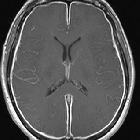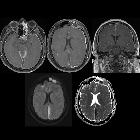intracranial infections






This article aims to be a collection of articles that represent central nervous system infectious (CNS) diseases.
Classification
By organsim
The organisms involved in CNS infections vary depending on the specific location of infection. Bacteria, viruses, fungi, parasites, and prions can all cause CNS infections.
See related articles below for a comprehensive list of organisms and their respective infections.
By location
Infections can involve any part of the CNS, including the meninges, ventricular system, brain parenchyma, cerebellum, brainstem, and spinal cord. Often, multiple parts of the CNS are involved at the same time (e.g. in meningoencephalitis).
See related articles below for a list of regions of the CNS which may become infected.
By route of transmission
There are numerous methods by which an infection may spread to the CNS, such as:
- haematogenous spread
- e.g. bacteremia as a result of distant infection
- direct spread
- e.g. acute sinusitis or acute otomastoiditis
- direct introduction
- e.g. iatrogenic or traumatic
Siehe auch:
und weiter:

 Assoziationen und Differentialdiagnosen zu Central nervous system infectious diseases:
Assoziationen und Differentialdiagnosen zu Central nervous system infectious diseases:



